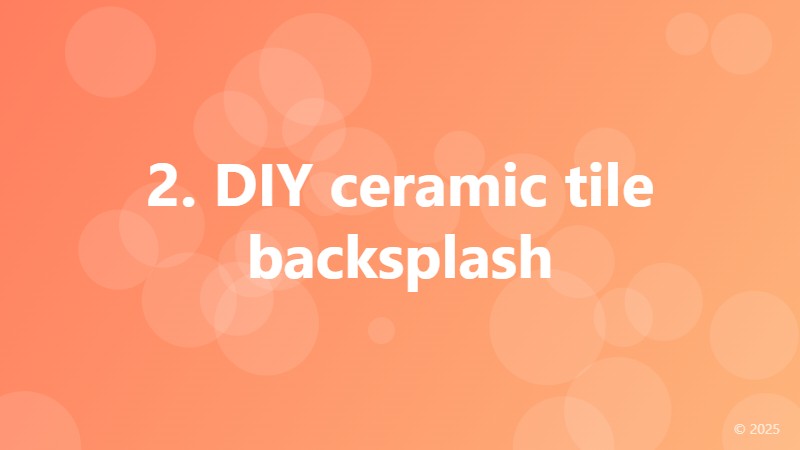2. DIY ceramic tile backsplash

Why a DIY Ceramic Tile Backsplash is a Great Idea
Are you tired of looking at the same old kitchen backsplash every day? Do you want to add some personality and style to your cooking space without breaking the bank? A DIY ceramic tile backsplash is a great idea for homeowners who want to give their kitchen a fresh new look without the hefty price tag of professional installation.
Benefits of a Ceramic Tile Backsplash
Ceramic tiles are a popular choice for kitchen backsplashes because they are durable, easy to clean, and resistant to heat and moisture. They come in a wide range of colors, shapes, and sizes, making it easy to find a style that fits your kitchen's unique aesthetic. Plus, ceramic tiles are relatively inexpensive compared to other materials like natural stone or glass.
Tools and Materials Needed
Before you start your DIY ceramic tile backsplash project, make sure you have the following tools and materials:
- Ceramic tiles (choose your desired color, shape, and size)
- Tile adhesive (also known as thinset)
- Grout
- Grout sealer
- Tile cutter or tile nippers
- Notched trowel
- Rubber grout float
- Grout sponge
Step-by-Step Guide to Installing a DIY Ceramic Tile Backsplash
Installing a DIY ceramic tile backsplash is a relatively straightforward process, but it does require some patience and attention to detail. Here's a step-by-step guide to help you get started:
Step 1: Prepare the Wall - Clean the wall thoroughly and apply a layer of tile adhesive. Let it dry completely before moving on to the next step.
Step 2: Lay Out the Tiles - Use a level and a pencil to mark the location of each tile on the wall. Start from the center and work your way outwards to ensure even spacing.
Step 3: Apply the Tiles - Use a notched trowel to apply a thin layer of tile adhesive to the back of each tile. Press the tile firmly into place, making sure it's level and even.
Step 4: Grout the Tiles - Mix the grout according to the manufacturer's instructions and apply it to the gaps between the tiles. Use a rubber grout float to spread the grout evenly and wipe away any excess with a grout sponge.
Step 5: Seal the Grout - Apply a grout sealer to protect the grout from stains and make it easier to clean.
Tips and Tricks for a Successful DIY Ceramic Tile Backsplash
Here are some tips and tricks to keep in mind when installing a DIY ceramic tile backsplash:
Use a level to ensure the tiles are straight and even.
Use a spacer to maintain even gaps between the tiles.
Work in small sections to avoid applying too much tile adhesive at once.
Use a damp cloth to wipe away any excess grout or tile adhesive.
By following these steps and tips, you can create a beautiful and functional DIY ceramic tile backsplash that will add value and style to your kitchen. So why not get started today?